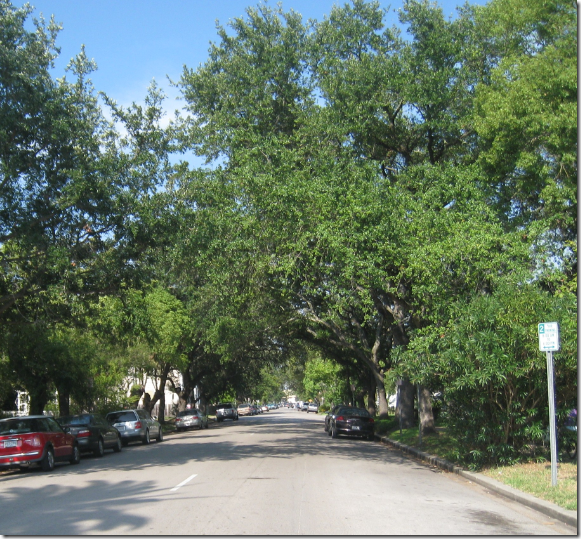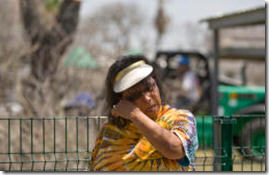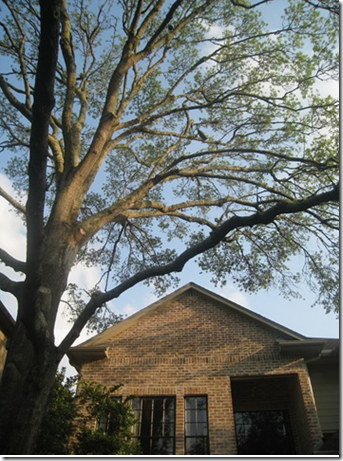Last August I took you on a photo tour (here) of this historic neighborhood in Galveston, Texas – a barrier island in the Gulf of Mexico, a quick 50 miles from Houston. The trees were as amazing as the houses, maybe even more so. A house can always be replaced; a tree – it’s not as easy.
 Galveston’s beautiful East End National Historical District – August, 2008. Towering, majestic Live Oak trees cast large shadows on the manicured lawns.
Galveston’s beautiful East End National Historical District – August, 2008. Towering, majestic Live Oak trees cast large shadows on the manicured lawns.
Live Oaks and oleanders – Galvestonians favorite landscape.
 These Live Oaks have grown so large, the house is barely visible.
These Live Oaks have grown so large, the house is barely visible.
The large limbs grow twisted from the constant harsh Gulf winds.
We even went inside one of the century old beauties (here.) This house, owned by friends, is full of linen slipcovers and seagrass. What’s not to love?
Last summer after Hurricane Dolly practically destroyed South Padre Island, my family vacationed on Galveston Island instead, just a quick hour away from Houston. Of course, Hurricane Edouard chased us back home a week early, just in time to greet the fury of Hurricane Ike. It wasn’t exactly a great summer for the Webb Family, but we have nothing to complain about. Ike was horrible to Bolivar and Galveston. Horrible. Katrina may have gotten all the publicity but Ike was just as terrible. I digress. Before Ike and Edouard, when I was all carefree and thrilled to be in Galveston, I took you on a photo tour of the historical districts – notable for their century old houses that survived the Great Storm of 1900. After that devastating storm, survivors rebuilt the city and planted thousands of Live Oak trees. Grown from just a tiny acorn, those Live Oaks have flourished, creating lush canopies over Galveston's streets and offering cool shade from the stifling summer heat. These majestic trees cast large shadows over the lawns and concrete and add an undeniable air of romance and southern charm to the older neighborhoods. Where these areas were once neglected and all-but abandoned, they are now teeming with life and activity, having undergone intensive revitalization. Awarded for all the hard work with the National Historic District designation, great effort and care has been taken to preserve the character and authenticity of the neighborhoods. Today, these historical district are now the most sought out places to live on the island.
Last August, I drove up and down these verdant streets, taking photographs of houses - some so obscured by the Live Oaks, they could be barely be seen. Each house, one after another, was more beautiful than the next. To find a favorite was an impossible task. Galveston’s East End and New Orleans’ Garden District look very similar and share many characteristics – architecture, the Live Oaks, but hurricane destruction may be the most obvious one. What Katrina did to New Orleans, Hurricane Ike did to Galveston – except it didn’t happen on the 24/7 news channels. Some of the worst damage caused by Ike was subtler than Katrina’s and it wasn’t immediately obvious. Yes, there was a great mess and many houses were destroyed. Boats landed on highways, miles from their slips, as if people had driven them there like cars. Landmark beach shops on piers that hovered over the Gulf were entirely washed away – shocking those of us who had been their customers since we were children. But, the debris was quickly cleaned up. Houses were fixed and rebuilt. Lives changed, but life goes on.
The dense canopy of Live Oaks shades the streets and the yards – creating a Southern, mysterious, and romantic atmosphere.
Yes, buildings and houses can be restored after a hurricane. But how do you replace something that is over 100 years old; something that grows from tiny to huge – a process that takes decades, not just a few months or years? You can’t just replace some things overnight, it is out of man’s control. You see, to understand the real damage of Ike, how Ike truly destroyed Galveston, you have to understand this: all these gorgeous Live Oak trees with their wide reaching canopies that give the East End – and the entire island of Galveston - its most beautiful natural resource, after the beach, are now all dead. Dead. Killed by the salt spray brought on by Ike or by the subsequent fungus that drove in the final nail if the salt didn’t kill them first.
Broadway, the once beautiful boulevard that welcomes all visitors – dead tree, after dead tree, after dead tree – as far as the eyes can see.
It’s hard to even write this, much less think about it – surely to see it and live it must be utterly heart breaking. If you don’t go visit, if you don’t witness it first hand, did it really happen? Forty one thousand, yes, you read that correctly, 41,000 Live Oak trees were killed by Hurricane Ike last September, and they are all coming down. The only Live Oaks getting a reprieve are those that have 30 percent new leaf growth – anything less, is history. Eighty percent of the tree canopy in Galveston is gone. I haven’t seen it yet. I’m pretending it still looks like it did last summer. It’s really hard to imagine that in one year – all those gorgeous Live Oaks are now dead. Driving around last August, happily trying to capture their beauty for you – it never occurred to me, not in a million thoughts, that in one month – all those trees would be dead.
To truly understand the oddity of this photograph – you must realize that Live Oaks do not lose their leaves during winter – they remain green and leafy all year. Thus, a Live Oak is rarely, if ever, seen without its leaves. The only time a Live Oak looks like this, is if it is dying.
For the past year, Galveston and many different forestry organizations have been conducting surveys of all the island’s trees. Originally they tried to save as many as they could, attempting to leech the salt out of the root systems. Nothing worked. In fact, statistically, the Live Oaks were considered somewhat hardy against Ike, 40 percent survived. In comparison - all but 12 percent of the island’s magnolias and pecans died after Ike. Sycamore, mulberry and river birch were entirely wiped out at 100%. The island’s flowering symbol – the oleander proved strong, 60 percent survived. Palm trees won the prize though – only 8 percent didn’t make it.
Despite the heroic efforts to salvage as many trees as possible, the dying and dead ones are now public hazards – in another storm, with their damaged root systems, they could become hurtling projectiles and most would end up crashing through roofs, causing untold death and destruction. They need to be cut down before another big hurricane comes, and quickly. FEMA is paying for the tree removal – if – if they are cut down before September 12th, so the rush is now on.
Galveston will never look the same in my lifetime, but my grandchildren will one day enjoy the cool shade from a Live Oak in the East End.
 City workers are seen leeching salt from the ground in a futile attempt to save the Live Oaks.
City workers are seen leeching salt from the ground in a futile attempt to save the Live Oaks.
To remove large Live Oak trees like these, the cost starts at over $1,000. Many of Galveston’s residents are in the lower income bracket and could never afford the cost of the tree removal without the government’s help – so Galveston is frantically trying to comply with the September 12th deadline. There is now a mad rush to get all 41,000 Live Oaks cut down on FEMA’s dime. Desperate to save their own trees, residents are calling in, claiming to see new growth. The cut-off for a death sentence is if there is 30 percent new growth, but very few oaks have gotten the reprieve. 11,000 of the Live Oaks are on public lands, and the remaining 30,000 will be cut from private property. Visitors to Galveston are well familiar with the towering trees that line Broadway - the grand parkway onto the island. These grand Live Oaks and the colorful flowering oleanders evoke deep emotions in both the citizens of Galveston and its tourists, many of whom have visited the island each summer of their life. In order to relieve the emotion and anxiety – it has been decided that the Live Oaks lining Broadway - a symbol of Galveston almost as strong as the Gulf of Mexico - will be cut down last, after the tourist season is over.
Last month as the first tree was felled by FEMA – this resident was photographed wiping away tears – after all, her father had planted the tree from a tiny acorn. One person left this note on a tree scheduled to fall: “Thanks for keeping us cooler and cleaner and standing without complaint for years and years. Goodbye.”

What a disaster.
It’s like there was a fire, yet the houses were not burned.
The Live Oaks are dead, but the palm is healthy and thriving. Galveston is planning to replant Live Oaks – citing the fact that 60% of the Live Oaks withstood Ike’s fury. Palms on the other hand lost only 3 percent of their ranks.
Just to give you an idea of Ike’s physical destruction, this debris is on the seawall. The beach is at the right. The tattoo parlor stands, as does the palm.
One of the stranger sights were the boats lined up on the main causeway leading into Galveston. It was as if someone had driven them on the road.
Just north of Galveston is Bolivar Peninsula – an area filled with beach houses, as you can see here right before Ike hit. Bolivar received the worst of Ike’s wrath. It is a true human and animal tragedy that happened there that night.
A week after – nothing much is left between the two houses. In Houston, we are lucky – 50 miles away, we just have to deal with wind gusts and rising water and no electricity, nothing like what these poor souls faced. We are praying that this season will be a Hurricane-Free summer.
And finally, last year, I wrote about our own Water Oak tree (here), how it had gotten sick and today, despite all our efforts, it’s future is still unknown. I lamented the loss of one tree, albeit a gorgeous, tall, sheltering tree and the primary reason we chose to buy this lot in the first place. It’s hard for Ben and I to imagine what it will be like if we have to take it down. The subject of the tree upsets us both greatly and it is something we avoid discussing. But, it’s just one tree. What pain the homeowners in Galveston must be going through as they watch their leafless trees cut down this summer. The Historical Districts are going to be so different now, so bare, so naked, so bright without the shade and shadows cast by the tall Live Oaks. I know that I, and probably most people do too, take our trees for granted, expecting them to be here forever. But trust me, it can change within one short month.































0 comments:
Post a Comment